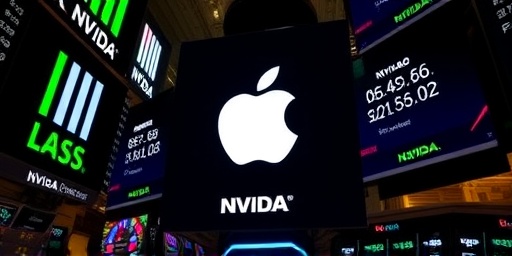In a triumphant surge that captivated investors worldwide, the US Stock market closed at unprecedented levels on Friday, with the Nasdaq Composite Index skyrocketing 3% to shatter its previous records. This tech rally was fueled primarily by blockbuster earnings reports from semiconductor powerhouse Nvidia and consumer electronics giant Apple, signaling robust confidence in the ongoing artificial intelligence (AI) boom despite lingering global economic headwinds.
The Dow Jones Industrial Average climbed 1.2%, while the S&P 500 advanced 2.1%, marking the broadest market gains in months. Trading volume spiked as retail and institutional investors alike piled into technology stocks, pushing the overall market capitalization past $50 trillion for the first time. Nvidia’s shares alone jumped 12% in after-hours trading following its announcement of quarterly revenues that exceeded analyst expectations by 25%, underscoring the insatiable demand for AI chips.
Apple, not to be outdone, reported a 15% year-over-year increase in iPhone sales, largely attributed to new AI-integrated features in its latest devices. CEO Tim Cook highlighted during the earnings call, "We’re at the dawn of an AI revolution, and our ecosystem is perfectly positioned to lead it." These results have reignited optimism on Wall Street, where the Stock market‘s performance is increasingly tied to the fortunes of Big Tech.
Nvidia’s AI Dominance Drives Explosive Earnings Growth
Nvidia’s latest earnings report has become the undisputed catalyst for this week’s tech rally. The company, a linchpin in the AI infrastructure race, posted fiscal fourth-quarter revenues of $22.1 billion, smashing forecasts of $18.5 billion. This figure represents a staggering 265% increase from the same period last year, propelled by sales of its H100 and upcoming Blackwell AI processors to data centers operated by hyperscalers like Microsoft and Google.
Chief Financial Officer Colette Kress emphasized the sustainability of this growth during the post-earnings conference. "Demand for our GPUs remains unprecedented," she stated, noting that Nvidia’s order backlog now exceeds $100 billion. Analysts at Goldman Sachs upgraded their price target for Nvidia shares to $1,200, citing the company’s near-monopoly in high-performance computing essential for training large language models.
However, not all is seamless in Nvidia’s ascent. Supply chain constraints, exacerbated by geopolitical tensions in Taiwan—home to key manufacturing partner TSMC—have raised concerns about potential bottlenecks. Despite this, the Stock market‘s reaction was overwhelmingly positive, with Nvidia’s market cap briefly surpassing $3 trillion, making it the world’s most valuable company for a fleeting moment.
To contextualize Nvidia’s impact, consider its role in the broader ecosystem. The company’s chips power everything from ChatGPT to autonomous vehicles, and partnerships with automakers like Tesla have further diversified its revenue streams. In the last quarter alone, automotive AI sales grew 40%, a segment expected to contribute significantly to future earnings. This multifaceted growth has investors betting big on Nvidia as the ultimate winner in the AI arms race.
Apple’s Earnings Boost Signals Resilient Consumer Demand
Complementing Nvidia’s fireworks, Apple’s earnings release painted a picture of steady innovation amid economic uncertainty. The tech behemoth reported total revenue of $119.6 billion for its fiscal first quarter, surpassing estimates by $2.3 billion. Services revenue, including Apple Music, iCloud, and the burgeoning Apple TV+, hit a record $25.4 billion, up 11% year-over-year, highlighting the stickiness of its subscription model.
iPhone sales, which account for over half of Apple’s revenue, reached $69.7 billion, driven by the iPhone 15 series’ AI-enhanced Siri and computational photography features. "Consumers are embracing AI in their daily lives," Cook remarked, pointing to a 20% uptake in AI-related app downloads since the launch. Wearables and services segments also shone, with Apple Watch sales climbing 8% and Mac revenues rebounding on AI-optimized chips like the M3 series.
Yet, Apple’s path forward isn’t without hurdles. Regulatory scrutiny from the European Union over app store policies and antitrust probes in the US could pressure margins. Additionally, softening demand in China—where iPhone shipments dipped 5%—poses risks, as the region represents 20% of global sales. Despite these challenges, the stock market responded bullishly, with Apple’s shares rising 8% and analysts from JPMorgan forecasting sustained double-digit growth through 2025.
Apple’s earnings also underscore a key trend in the tech rally: the convergence of hardware and software in AI applications. Initiatives like Apple Intelligence, set to roll out later this year, promise deeper integration of generative AI, potentially unlocking new revenue from enterprise partnerships. This positions Apple not just as a device maker, but as a comprehensive AI platform, appealing to a wide swath of investors in the Nasdaq-heavy portfolios.
Nasdaq’s Record-Breaking Climb Amid Broader Tech Rally
The Nasdaq’s 3% leap to an all-time high of 16,500 points encapsulates the fervor of this tech rally, outpacing other indices and drawing comparisons to the dot-com boom of the late 1990s—albeit with more grounded valuations today. Magnificent Seven stocks, including Nvidia, Apple, Microsoft, and Amazon, accounted for over 60% of the index’s gains, with collective market caps exceeding $15 trillion.
Market data from Bloomberg shows that AI-themed ETFs saw inflows of $5.2 billion in the past week alone, the highest since the ChatGPT launch in late 2022. The PHLX Semiconductor Index, a bellwether for tech hardware, surged 5.2%, benefiting from spillovers in the supply chain. Companies like AMD and Broadcom also posted strong gains, with AMD’s shares up 10% on raised guidance for AI data center products.
Investor sentiment, as gauged by the AAII Investor Confidence Survey, hit its highest level in six months, with 52% of respondents bullish on the stock market. Hedge funds, per 13F filings, have increased exposure to tech by 15% in Q4, rotating out of underperforming cyclicals like energy and materials. This shift reflects a belief that the AI boom will sustain economic growth, even as the Federal Reserve signals potential rate cuts in 2024.
However, the Nasdaq’s concentration risk is evident: the top five holdings represent 28% of the index, raising bubble fears among skeptics. Volatility metrics, such as the VIX, ticked up slightly to 14, indicating mild unease. Still, the tech rally’s momentum appears intact, with options trading showing heavy call buying on Nasdaq futures.
Global Uncertainties Temper Enthusiasm for Stock Market Surge
While the US stock market basks in record highs, global uncertainties cast a shadow over the celebrations. Escalating tensions in the Middle East have driven oil prices to $85 per barrel, potentially fueling inflation and prompting the Fed to delay rate cuts. In Europe, sluggish growth forecasts from the ECB—projecting just 0.8% GDP expansion for 2024—contrast sharply with America’s tech-fueled optimism.
China’s economic slowdown, marked by a 4.6% GDP growth rate in Q3, has ripple effects on the supply chain. Nvidia and Apple, both heavily reliant on Asian manufacturing, face tariff risks if US-China trade relations deteriorate further. A recent report from the IMF warns that geopolitical fragmentation could shave 7% off global trade volumes by 2025, indirectly pressuring tech earnings.
Economists like those at Moody’s Analytics note that while the tech rally provides a buffer, broader stock market health depends on consumer spending. US retail sales rose 0.7% in October, but holiday season projections are tempered by high interest rates. Federal Reserve Chair Jerome Powell, in a recent speech, cautioned, "Innovation in AI is exciting, but we must remain vigilant against overheating."
Despite these headwinds, the disconnect between US tech strength and global woes has led to a 12% premium in Nasdaq valuations over international peers, per MSCI data. Currency fluctuations, with the dollar strengthening 2% against the euro, further complicate multinational earnings translations for companies like Apple.
Outlook: AI Boom Poised to Shape Future Stock Market Trends
Looking ahead, the stock market’s trajectory hinges on the AI narrative’s endurance. Analysts project that global AI spending will reach $200 billion by 2025, per IDC research, creating tailwinds for Nvidia and Apple. Upcoming earnings from peers like Microsoft and Alphabet, due next week, could extend the tech rally if they echo similar AI-driven beats.
Investors are eyeing Federal Reserve minutes for clues on monetary policy, with a 75% probability of a March rate cut baked into futures markets. If realized, this could lower borrowing costs for tech firms expanding data centers, estimated to require $1 trillion in investments over the next five years by McKinsey.
Emerging opportunities include edge AI for consumer devices and enterprise software, where startups could disrupt incumbents. Venture capital funding in AI hit $50 billion in 2023, signaling a pipeline of innovation that might fuel the next wave of Nasdaq gains. However, sustainability investors urge caution, pointing to AI’s energy demands—equivalent to 10% of global electricity by 2026—as a potential drag.
For retail investors, diversified ETFs tracking the Nasdaq offer accessible entry points, but experts recommend balancing with defensive sectors. As one Morningstar strategist put it, "The tech rally is real, but prudence will define long-term winners in this stock market cycle." With earnings season in full swing, the coming months will test whether this record high is a launchpad or a peak.









